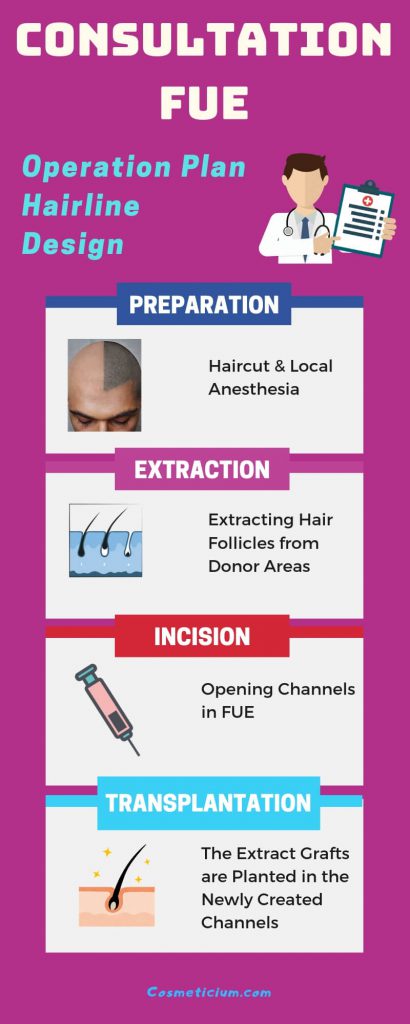FUT hair transplantation method is especially applied in the 90s, but it is no longer preferred. The most prominent feature of this method is the removal of hair follicles from the selected donor area as a strip. In the later transplantation methods, strip removal was abandoned. Hair follicles are being collected in different ways. The main feature that differentiates FUT method, which is an old application, is collecting the hair follicles as strips.
Table of Contents
How is FUT Implemented?
In the beginning, the donor region is selected to apply the FUT method. Local anesthesia is performed to make the patient feel more comfortable before the operation. Then, an area where the hair follicles will be collected is cut in a rectangular shape with a length of 15 cm and a width of 2 cm. The skin in this rectangular region is removed. How much area should be cut depends on the hair follicles that are required. In hair transplantation operations hair follicles are collected and applied to the region where balding is seen. These hair follicles are called grafts. If the hair follicles of the patient to be transplanted are thin and more grafts are needed, a larger area is needed but if he/she doesn’t have such problems, a shorter area can be cut.
The Preparation of the Grafts
During the FUT application, a sorting process is performed to collect grafts on the piece of the skin that is cut from the head. This process should be done carefully. The piece of the skin and grafts are separated and the grafts placed are in the tubes called Petri plates after being extracted one by one. This process may last long or short depending on the number of grafts needed.
The processes after the preparation of the grafts are similar to other methods. Channels are opened to transplant the hair on the area where hair loss is obvious. Before this procedure, local anesthesia should be performed to make the patient more comfortable. Then, grafts are placed on these channels that are opened. These channels should not be too wide. This is important for the image that will form later on. Channels are opened in accordance with the number of grafts to be placed, the grafts are placed and FUT hair transplantation method is completed in this way.
Negative Aspects of FUT Hair Transplantation
The most disadvantageous aspect of the FUT method is the scar on the donor area at the back of the head. After transplantation, this area is wrapped and recovers after approximately 1 month. However, a line mark remains on the neck of the patient, revealing the cut from one ear to the other. In addition, the process of healing and wearing off the pain felt by the patient may take a little longer. Sometimes there may be problems such as a numbness or hair turn on the area where the hair follicles are taken.

The FUT method is therefore considered to be disadvantageous compared to the new advanced methods. In the new methods of hair transplantation, such a piece of skin is not cut. However, in some cases the FUT method can still be used. For example, if the hair in the donor area of the patient is very rare or very dense on the contrary, FUT method can be suggested as the only way to prevent damage to other hair follicles while the grafts are being collected. FUT can be preferred in order to retouch on a certain area rather than baldness on a large area.
The Best Alternative Methods: FUE and DHI
The Most Frequently Preferred: FUE Method
In FUE method which is one of the latest methods in hair transplantation, there isn’t any cutting process on the donor area like FUT. This is the main reason why this method is more prominent and prevents the over-use of the FUT method. In this method, the donor site is also anesthetized by locally. Equipments with special tips are used to collect hair follicles. It is possible to collect grafts with them. Since grafts are collected one by one, no cutting is performed on the donor area. Grafts are collected with specially developed equipments and placed on the new area after opening the channels. The FUE method is currently used as the most common method.
As there is no cutting on the donor area, the time for recovery is shorter in this planting method. Also, there won’t be any scars of stitches on the donor area. Only small redness and abrasions occur after the collection process and they will recover within a short time.
You May Also Like: Difference Between DHI and FUE
Tips for the FUE Transplantation Method
The grafts collected with the FUE method can be used not only for hair but also for beard, mustache and eyebrow. Since the grafts are collected individually from the donor area, the recovery time is quite short and there is no scar. It is also possible to collect some more grafts thanks to this method.

After this method, the first coming hair is lost, and then after 2 or 3 months, your hair will come out more vividly. This shock loss of the hair after the transplantation is a natural consequence of the operation and it is definitely not a condition that requires concern. The most important advantage of the FUE method is that the feeling of pain is minimal and the pace of recovery is very fast.
The Latest Method in Hair Transplantation: DHI
DHI hair transplantation method is only one of them. DHI is a method called “direct hair transplantation”. It is also used with the name of “pen hair transplantation”. DHI is the operation in which the hair follicles collected are transplanted to the hairless area with the help of pencils which are specially produced and developed. These pens, called “DHI pens”, enable both grooving and hair transplantation to take place simultaneously.
DHI hair transplantation is completed in 3 stages. Firstly, the grafts are collected. These grafts are then placed in the DHI pens. Finally, sowing process is done without requiring any grooving. In this way, DHI hair transplantation is completed.
A Short Comparison
The FUT is the oldest method in this field and is hardly used. However, it may be preferred by surgeons and specialists in some special cases.
DHI is advantageous because it is the newest method and the hair follicles are transplanted without waiting. But when compared with the other two methods, DHI operation may take a little longer. In addition, the surgeon should be highly specialized in this field as it is a more sensitive method. Therefore; although the cost is not considered high, it is slightly more expensive than the FUE method. This process also takes a little longer than the others. Preparations for the operation may take a little longer although the grafts are kept for a shorter time.
The recovery time of the DHI method is shorter than the FUE method. The reason for this is that there is no need to open large channels in the DHI method, which means less transplantation scars and less bleeding.
Most of the clinics are now widely experienced in the FUE method and it is a widely applied method. Of course, there is no trace and the time for recovery is short in DHI, too.
You May Also Like: Which Hair Transplantation Method Is Best for You? | FUE or DHI?
CONCLUSION
As a conclusion, the most advanced and frequently used DHI and FUE methods will be the right options for you. When you decide on hair transplantation, you should choose an experienced clinic or a center having fulfilled all the necessary requirements and working with specialist physicians. This is the most important point in hair transplantation. You should choose your clinic very carefully to avoid any risk. Then which method is better for you and which will be preferred are determined and the operation is completed. Of course, the patient’s preferences can also be considered.
You Can Check Out This Page to Get More Information About Hair Transplant in Turkey

